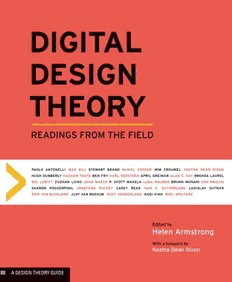Table Of ContentDIGITAL
DESIGN
THEORY
READINGS FROM THE FIELD
Edited by
Helen Armstrong
PRINCETON ARCHITECTURAL PRESS
NEW YORK
Published by
Princeton Architectural Press
A McEvoy Group company
37 East Seventh Street
New York, New York 10003
Visit our website at www.papress.com
© 2016 Princeton Architectural Press
All rights reserved
No part of this book may be used or reproduced in any manner without
written permission from the publisher, except in the context of reviews.
Every reasonable attempt has been made to identify owners of copyright.
Errors or omissions will be corrected in subsequent editions.
Design Briefs Series Editor: Ellen Lupton
Editor: Nicola Brower
Special thanks to: Janet Behning, Erin Cain, Tom Cho, Barbara Darko,
Benjamin English, Jenny Florence, Jan Cigliano Hartman, Lia Hunt,
Mia Johnson, Valerie Kamen, Simone Kaplan-Senchak, Stephanie Leke,
Diane Levinson, Jennifer Lippert, Sara McKay, Jaime Nelson Noven,
Rob Shaeffer, Sara Stemen, Paul Wagner, Joseph Weston, and Janet Wong
of Princeton Architectural Press —Kevin C. Lippert, publisher
Library of Congress Cataloging-in-Publication Data
Digital design theory: essential texts for the graphic designer/
Helen Armstrong.—First edition.
pages cm
Includes bibliographical references and index.
ISBN 978-1-61689-308-8 (alk. paper)
ISBN 978-1-61689-495-5 (epub, mobi)
1. Graphic arts—Data processing. 2. Commercial art—Data processing.
I. Armstrong, Helen, 1971– editor.
NC1000.5.D54 2016
41.60285—dc23
2015027140
LE. LICS.
P E
O D
E E
P H
E YC
H S
T P
O E
T C
G N
N SI
MI T
O S
C E
RE E B
A H
RS E T
E B
T Y
U A
P M
M S,
O W
C
T, NE
O D
N O
R O
O G
Y S
D T’
A A
E H
R T
STEWART BRAND
“Spacewar—Fanatic Life
and Symbolic Death Among
the Computer Bums”
1972
CONTENTS
6 Building Towards a Point of Always Building:
A Visual Foreword | Keetra Dean Dixon
8 Acknowledgments
9 Introduction: Giving Form to the Future
18 Timeline
SECTION ONE: STRUCTURING THE DIGITAL
21 Introduction
22 Visual Design in Action | Ladislav Sutnar | 1961
28 Arte Programmata | Bruno Munari | 1964
30 Designing Programmes | Karl Gerstner | 1964
36 The Ultimate Display | Ivan E. Sutherland | 1965
39 Structure as Art? Art as Structure? | Max Bill | 1965
41 Whole Earth Catalog | Stewart Brand | 1968
42 Type Design for the Computer Age | Wim Crouwel | 1970
48 Doing Wall Drawings | Sol LeWitt | 1971
50 THEORY AT WORK: 1960s–1970s
SECTION TWO: RESISTING CENTRAL PROCESSING
57 Introduction
58 Creativity and Technology | Sharon Poggenpohl | 1983
62 Does It Make Sense? | April Greiman | 1986
64 Computers and Design | Muriel Cooper | 1989
72 Ambition/Fear | Zuzana Licko and Rudy VanderLans | 1989
75 User Interface: A Personal View | Alan Kay | 1989
82 Is Best Really Better | Erik van Blokland and Just van Rossum | 1990
86 Redefining Display | P. Scott Makela | 1993
8 8 Design by Numbers | John Maeda | 1999
90 THEORY AT WORK: 1980–2000
SECTION THREE: ENCODING THE FUTURE
97 Introduction
98 Processing...| Ben Fry and Casey Reas | 2007
1 06 Design and the Elastic Mind | Paola Antonelli | 2008
111 Design in the Age of Biology: Shifting from a Mechanical-Object
Ethos to an Organic-Systems Ethos | Hugh Dubberly | 2008
1 20 Conditional Design: A Manifesto for Artists and Designers |
Luna Maurer, Edo Paulus, Jonathan Puckey, Roel Wouters | 2008
122 D esigned Animism | Brenda Laurel | 2009
126 Conversations with the Network | Khoi Vinh | 2011
132 Museum as Manufacturer | Keetra Dean Dixon | 2013
1 34 Posthuman-Centered Design | Haakon Faste | 2015
138 THEORY AT WORK: 2000–PRESENT
145 Glossary
147 Text Sources
148 Bibliography
150 Credits
151 Index
BUILDING TOWARDS A POINT
OF ALWAYS BUILDING: A Visual
Foreword by Keetra Dean Dixon
BUILDING TOWARDS
A POINT OF
ALWAYS BUILDING
ACKNOWLEDGMENTS
Essential to this project, of course, are the many eminent designers
who graciously contributed their work. Special recognition goes to Lenka
Kodýtková, Radoslav L. Sutnar, Alberto Munari, Wim Crouwel, Jakob Bill,
Laura Hunt, and Nicholas Negroponte for their help negotiating the maze
of copyright permissions inherent to a project such as this. I would also
like to express deep gratitude to Dr. Glenn Platt and Dr. Bo Brinkman for
their continuing insights and to Peg Faimon, a wonderful designer, friend,
and mentor. Without Peg’s support, this book would not have been possible.
A special thanks to my students—Ali Place, Danny Capaccio, Ringo
Jones, Kansu Özden, and Paulina Zeng—who provided a strong sounding
board for this collection in the classroom, never failing to inspire through
their own energy and creativity. At Princeton Architectural Press, my
gratitude goes to my editor, Nicola Brower, for her thoughtful comments.
Finally, thanks go to my husband, Sean Krause, for his patience, love, and
editing skills, and to my daughters, Vivian and Tess, who remind me each
day what this crazy life is really about.
8 | Digital Design Theory

